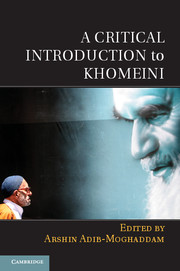Book contents
- Frontmatter
- Contents
- List of Map and Figures
- About the Authors
- Acknowledgments
- Glossary
- Timeline: The Life of Ayatollah Ruhollah Khomeini (1902–1989)
- Introduction Ayatollah Ruhollah Khomeini: A Clerical Revolutionary?
- 1 Khomeini and the “White Revolution”
- 2 The Rise of Khomeinism
- 3 Wilayat al-Faqih and the Meaning of Islamic Government
- 4 Ayatollah Khomeini’s Rule of the Guardian Jurist
- 5 Khatt-e Imam
- 6 Khomeini and the West
- 7 Gendered Khomeini
- 8 Hidden Khomeini
- 9 The Divine, the People, and the Faqih
- 10 Khomeini’s Legacy on Women’s Rights and Roles in the Islamic Republic of Iran
- 11 To Rule, or Not to Rule? An Alternative Look at the Political Life of Ayatollah Khomeini between 1960 and 1980
- 12 Khomeini and the Decolonization of the Political
- 13 Contentious Legacies of the Ayatollah
- Further Reading
- Index
- References
11 - To Rule, or Not to Rule? An Alternative Look at the Political Life of Ayatollah Khomeini between 1960 and 1980
Published online by Cambridge University Press: 05 June 2014
- Frontmatter
- Contents
- List of Map and Figures
- About the Authors
- Acknowledgments
- Glossary
- Timeline: The Life of Ayatollah Ruhollah Khomeini (1902–1989)
- Introduction Ayatollah Ruhollah Khomeini: A Clerical Revolutionary?
- 1 Khomeini and the “White Revolution”
- 2 The Rise of Khomeinism
- 3 Wilayat al-Faqih and the Meaning of Islamic Government
- 4 Ayatollah Khomeini’s Rule of the Guardian Jurist
- 5 Khatt-e Imam
- 6 Khomeini and the West
- 7 Gendered Khomeini
- 8 Hidden Khomeini
- 9 The Divine, the People, and the Faqih
- 10 Khomeini’s Legacy on Women’s Rights and Roles in the Islamic Republic of Iran
- 11 To Rule, or Not to Rule? An Alternative Look at the Political Life of Ayatollah Khomeini between 1960 and 1980
- 12 Khomeini and the Decolonization of the Political
- 13 Contentious Legacies of the Ayatollah
- Further Reading
- Index
- References
Summary
There is a consensus among both supporters and opponents of the late Ayatollah Khomeini that he was set to rule: when he first began his political life in the early 1960s through to the early 1980s, when, for all intents and purposes, he actually did emerge as the undisputed ruler of the Islamic Republic within the context of Velayat-e Faqih (guardianship of the jurist). His supporters argue that from the time he launched his struggle against the late Shah of Iran, Mohammad Reza Pahlavi (1919–1980), in the 1960s, Ayatollah Khomeini was determined to establish a clerical state in Iran. They have several fundamental arguments to support their claim. First and foremost, they cite Khomeini’s theory of the Velayat-e Faqih; a theory he developed during his exile in Najaf in Iraq (1964–1978) and taught to elite students that would go on to form the Islamic Republic. The theory postulates that during the absence or “occultation” of the Shi’i Twelfth Imam, which began in the ninth century (874 ce), a top-ranking Shi’i cleric or Vali-e Faqih was obligated to rule the Shi’i community until his reappearance. This idea had been raised by Shi’i scholars since the occultation, but for the most part remained a broadly theoretical subject, and not a definitive religious decree to be abided by Shi’i in the absence of the Twelfth Imam. According to Khomeini’s interpretation, however, a high-ranking Shi’i theologian or faqih enjoys the same authority enjoyed by the Twelfth Imam. Ayatollah Khomeini’s interpretation of the concept of Velayat-e Faqih ultimately leads to the absolute power of the ruling faqih and the state being governed by the clergy under the supervision of the faqih.
- Type
- Chapter
- Information
- A Critical Introduction to Khomeini , pp. 256 - 274Publisher: Cambridge University PressPrint publication year: 2014
References
- 3
- Cited by



